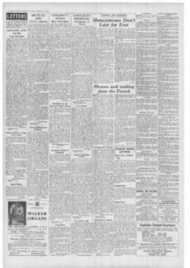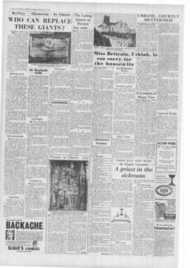Page 8, 12th February 1954
Page 8

Report an error
Noticed an error on this page?If you've noticed an error in this article please click here to report it.
Tags
Share
Related articles
A Roll Of Drums For M.-g.-m.
A Man With A Conscience
I A Rewarding Experiencel
The Critics
In A Few Words
Oil, turmoil and desperation . .
By GRACE CON WAY 'Catholic Herald' Film Critic
THE WAGES OF FEAR (Academy: Certificate A) Director: H. G. Clourot
THE Academy, after being closed for decoration and repairs, opens its new and impressive doors with this Cannes Festival award-winning, stark, crude, sociological study—almost documentary in parts—of Oil.
Oil is the food and drink of the modern world. It gushes out of the earth in some very ugly and unpleasant places. When it comes, as one of the film's polyglot flotsam and jetsam characters remarks, you will find Americans.
And so they are here, in control of extensive wells "somewhere in central America" not defined, but Caracas is mentioned as the nearest point of civilisation.
In the settlement headquarters is gathered a multi-lingual assortment of human failures, Spanish, French, German, American—many of them too worthless even for the oil company to employ. They have drifted there and have no money to get away. The only transport is by plane and the fare is beyond their reach.
So they hang about the local inn, dirty, unkempt. unshaven. cadging when there is anyone to cadge from, or being thrown out by Hernandez the landlord.
Then something happens which promises work even to the lowest of the hangers-on. One of the oil wells blows tip and the company decides to "snuff it out" with nitro-glycerine.
This will have to be taken on lorries 300 miles across the rough. perilous roads and delivered to the base. The merest vibration. the slightest jolt. and the lorry, drivers, and all will be blown to little bits.
Four eager men
Four of the down-and-outs. grasping only too eagerly at the $200 apiece fee, set out on the grim excursion.
They are a Corsican, Mario (Yves Montant); Jo, a French Braggart (Charles Vanel); Luigi, an Italian already dying of cement in the lungs (Folco Lulli); and Bimba, a Dutchman whose hair has gone prematurely white while in the Nazi salt mines (Peter van Eyck).
Two lorries, each with a team of two, set mit.
From that moment prepare to have your nerves twisted and wrenched and pulverised. Which is what M. Clouzot sets out to do.
Death sits beside them all the way. The tough guy is the first to lose his nerve. The friendship that blossomed so suddenly between him and Mario cracks under the strain.
The Italian and the Dutchman work much better as a team. When, after overcoming terrible dangers, their lorry blows up, their death at least seems to be brave and honourable.
The most frightful thing that happens to the other two is getting their lorry bogged down in a crater of water and oil made by the first lorry's explosion. Jo gets out to sound its depths and Mario runs over him. He dies an oily, pitiful death as the lorry at last reaches the flaming wells.
The grand finale of this human sacrifice on the altar of Oil comes when Mario, the only survivor, cleaned up and shaven, drives back with his and Jo's prize-money, all set for a gay reunion with the little halfcast girl (Vera Clouzot) at the inn.
On his radio set he can hear a waltz being played. Intoxicated with his survival, he twists his lorry about the road in a gay waltz. It crashes down the ravine.
I tell the story at some length because I don't think the film is for the tensitive and the nervy. It is very much a man's film—eith its involved mechanics. its tough jobs and its essentially masculine relationships. Note that it has an A Certificate in spite of its one "Clechemerle" interlude which the British may not condone even if the French do.
YOU KNOW WHAT SAILORS ARE
Odeon, Leicester Square: Certificate U Director: Ken Annakin
HE Royal Navy takes time off for fun. That's cinema news after the blood, sweat, tears, toil. oil and salt water which have so far marked our tales of the sea.
We now know what sailors are outside the stress of war—or at any rate one sailor, Lieut. Sylvester Green (Donald Sinden)—who. returning "lit up" to his ship one night, helps himself en route to a pawnbroker's sign and an old broken perambulator, welds them to the deck of an adjacent foreign desfro) Cr,. paints them battleship grey and finds next day that they have been taken for a new secret weapon.
The British command wants to know why a foreign country should have this device first. The complicated office machinery of the Navy is put in motion, and from the austere dockside the scene shifts to the lush country to which the foreign destroyer belongs — a world of harems, desert sands, donkeys, camels, marble and mosaic. (Did I say it was in Technicolor?)
Except on the few occasions when it tries to ape Hollywood (e.g., Bill Kerr addressing the camera a la Bob Hope), this is good fun.
Especially welcome is its tilt at the international boffins established behind the frontiers of every little country in the world, who play about in their sacrosanct laboratories with test tubes, bunsen burners, retorts and atoms.
As Prof. Hyman Pfumbaum, Martin Miller balances his portrait adoitly between the true and the fantastic and never crosses the border into caricature. The result a richly comic bit of observation. His encounter with thc boffin on the other side of the frontier (Ferdy Mayne) whose rockets form a bristly menacing fringe pointing outward, is a combination of witty dialogue, expert character acting and expert handling by Director Annakin.
Among the Navy types are Naunton Wayne and Michael Shepley, and as the President of the foreign power who become so unwittingly owners of the new secret weapon. Akim Tamiroff runs away with a good deal of the picture.
THE RUNAWAY BUS Dominion: Certificate U Director: Val Guest
RANK1E HOWERD, so well known on stage, television and radio, comes, many will think, tardily to the screen. Val Guest, who has written, produced and directed "The Runaway Bus," has chosen a comedy thriller in which to launch him.
Since practically the whole action takes place in a fog and largely in one spot, it must have been a very difficult film in which to sustain movement and interest—and especially for Mr. Howerd, whose first experience of filming this was, In spite of this handicap, his very individualistic type of comedy gets across well, even though he has to suffer an inordinate number of mishaps—getting plastered with white paint, falling into a river, crashing through a ceiling, to mention but a few. No wonder sometimes he seems at a loss for words.
The story woven around him is the theft of gold bars from the airport to which Frankie is attached as a relief coach driver. Out of his halfdozen passengers—among whom are Margaret Rutherford as a member of the Positive Thought Society, and George Couloris, a mystery man— he knows one of them is the thief.
His agonised conversations on the coach's radio with headquarters, carried on against fearful odds and interrupted by a gun stuck in his back—this is the sort of thing that the comedian knows well how to handle.
Frankie Howerd wants to make good on the films. There is room for him, and he should.
If you are going to see this, don't try to find out the real thief unless you don't mind losing some of your money's worth.
TWO ROYAL TOUR FILMS
"THE Royal Tour" (Howard 1 Thomas) Gaumont, and "Royal New Zealand Journey" (Castleton Knight) Odeon, Leicester Square.
The first of these takes half an hour and is one of a series which Path6 are presenting of the Queen's visit to the Commonwealth. It gives an interesting picture of New Zealand— the magnificent scenery—and it conveys very vividly the "feel" of the place, while following Her Majesty on her travels.
"Royal New Zealand Tour," the J. Arthur Rank record, lasts over an hour and takes in about that much more than the Howard Thomas picture. It is bright, impressive, often moving. in its shots of the crowds, its studies of faces, old and young, and all the time the Queen. with the Duke of Edinburgh at her side. moving with grace and charm in the carrying out of her formidable task.
blog comments powered by Disqus









